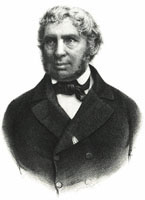Friedrich Neuhaus

Georg Ernst Friedrich Neuhaus (born September 20, 1797 in Behme near Herford , † December 4, 1876 in Berlin ) was a German architect and Prussian construction clerk . He became known as the CEO of the Berlin-Hamburg Railway . He designed most of the buildings and a number of technical systems on the lines of this railway company.
Life
After completing his training as a surveyor in Berlin and briefly at the Oberdeichinspektion in Crossen an der Oder , he studied and passed the state exam in 1824. As a construction referendar in the Prussian building administration, he was involved in the expansion of the roads and then became road construction inspector in Stargard in Pomerania . From 1840, he was in charge of the construction of the Berlin-Szczecin Railway as chief engineer . In 1843 he became a technical member of the management of the Berlin-Hamburg Railway (BHE) and directed the preparatory work for the construction of the railway. In 1850 he was elected chairman of the BHE. At the same time, he performed the duties of technical and operations director. In 1860 he was appointed a secret government building officer.
Several innovations in railway construction can be traced back to Neuhaus. So he introduced the bracket construction with which rail ends were connected to one another. The Breitfußschiene was used to Neuhaus' operate even at a time when some new standards for the hitherto usual double head rail were established.
He had the first wrought iron lattice bridge built in Germany in association with Borsig in Spandau over the Elsgraben and the construction of the approximately one kilometer long Dömitzer Elbe bridge for the Wittenberge-Buchholz branch line comes from him (1871–1874). The reception hall of the Hamburger Bahnhof in Berlin was built under his construction management .

The funeral oration on his death explains that it is seldom that a company has been led so predominantly by one person. In addition to his supervisory work, Neuhaus also handled all important matters himself, wrote almost all correspondence between the management and other railroad administrations, private individuals and the authorities, often using a stenographer . It was thanks to his way of doing business that, despite the unfavorable times and despite the addition of the Wittenberge-Buchholz branch line, which was still quite unprofitable for the time being, the company's earnings were not significantly reduced and were spared the difficulties that other railways suffered.
literature
- Dietmar Ramuschkat: The Wittenberge-Buchholz railway line. A case study about decision-making and action processes in the planning of a private railway in Prussia and the purchase of land required for construction. Dissertation, University of Hamburg, 2002. urn : nbn: de: gbv: 18-7764
Web links
- Joachim Scholz: The classicist stations of the Berlin-Hamburg railway
| personal data | |
|---|---|
| SURNAME | Neuhaus, Friedrich |
| ALTERNATIVE NAMES | Neuhaus, Georg Ernst Friedrich (full name) |
| BRIEF DESCRIPTION | German architect and Prussian building officer |
| DATE OF BIRTH | September 20, 1797 |
| PLACE OF BIRTH | Behme at Herford |
| DATE OF DEATH | 4th December 1876 |
| Place of death | Berlin |
